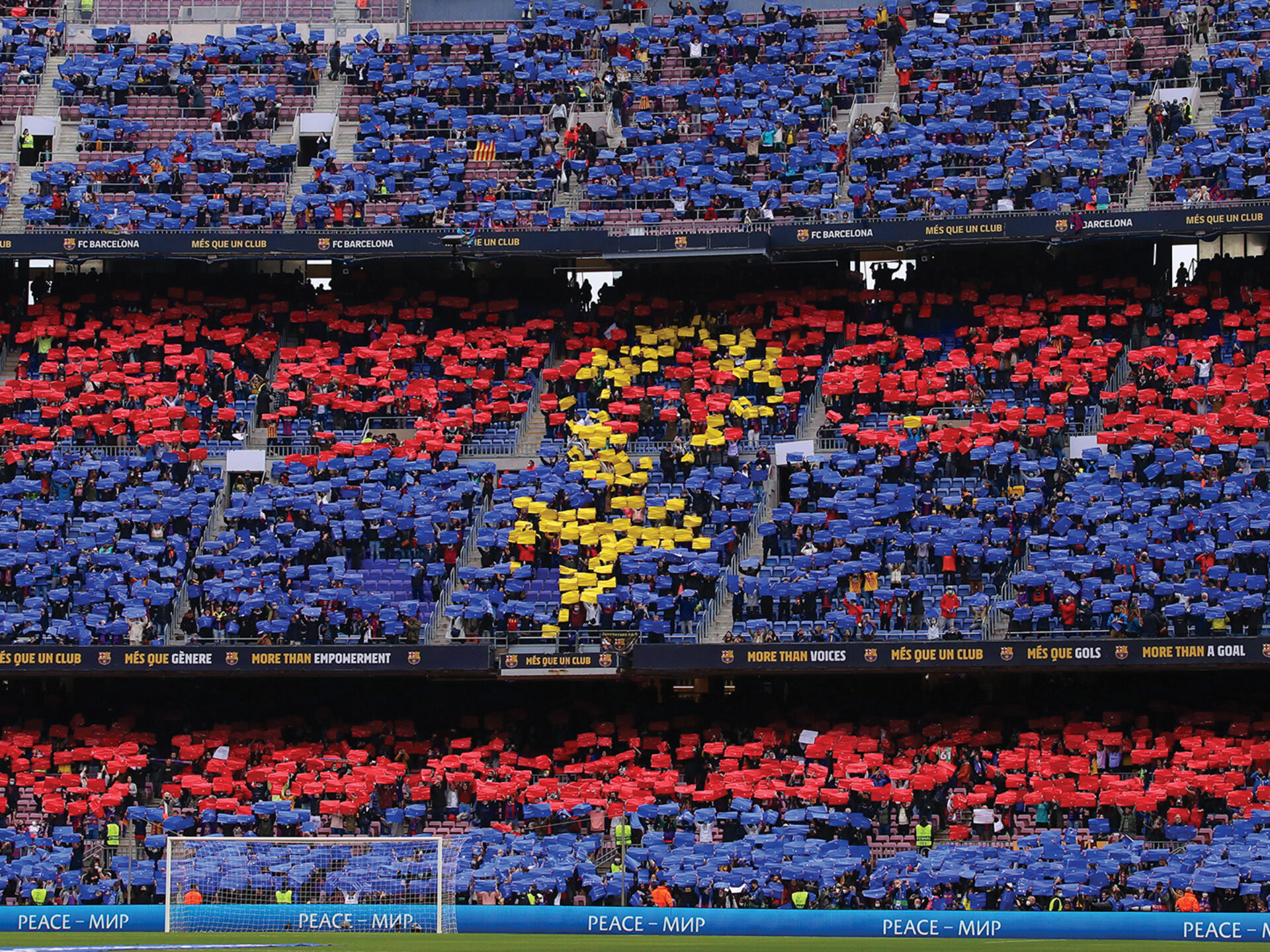Magazine

August 3, 2023

It had rained all the previous day in Barcelona, raising fears of a dampened mood but, as kick-off neared, the clouds parted and the party at the famous Camp Nou stadium took hold. Professional skaters, three-a-side basketball and futsal areas, sim-racing, face painting and live music created a festival atmosphere.
When Aitana Bonmatí raced through to give FC Barcelona’s women’s soccer team a second-minute lead, it was delirium unbound. In the end, the home side thumped VfL Wolfsburg 5-1 in their Champions League semi-final first leg. A remarkable result was made even more so by the attendance: 91,648, a world record for a women’s soccer match.
The numbers attending individual women’s games such as these have raised hopes that this year’s FIFA Women’s World Cup in Australia and New Zealand will break records. Organisers expect to sell 1.5 million tickets. Australia’s opening game has moved from the 45,000-capacity Sydney Football Stadium to the 80,000-capacity Stadium Australia.
The interest in live women’s sport is growing. The University of Nebraska volleyball team, for example, has just sold 82,000 tickets for a doubleheader in August 2023. A record 58,498 watched England and France in a Six Nations rugby union match in April. Last year, 19,100 people squeezed into Madison Square Garden to see Katie Taylor retain her lightweight boxing titles against Amanda Serrano.
Research from the Women’s Sports Trust and sports marketing company, Two Circles, in the UK, indicates that attendance at live events is the bedrock of habit and drives fans to the next level of engagement. The report draws evidence from women’s cricket, where the only British region that increased domestic attendance in 2022 was the West Midlands, thanks to interest created by the Commonwealth Games cricket event, staged there that summer. The report concluded that a captivating live atmosphere was perhaps the most significant factor in driving engagement with women’s sport.
For architects at Populous, this prompts fundamental questions: can you shape the fan experience in a way that brings in new audiences without alienating traditional ones, and what role can stadium design play in that?
“Stadia have been designed over the years with an implicit understanding that it would be male athletes and male teams you were watching,” says senior principal and director of Populous Italia, Silvia Prandelli. “We need to better consider what it would look like to design from a perspective that prioritises inclusivity and the needs of men and women.”
Talk of inclusive building design can fixate on toilet provision, important as it is, but the debate has to move beyond restroom ratios, for which local regulations already exist. Instead, there needs to be a focus on designing around the whole match-day experience for a wider group of fans and not simply the 90 or so minutes of game time.
“A key focus of modern stadium design is analysing what the attendance profile looks like today for sport in general, and for women’s events in particular,” says Prandelli. “If we begin without any preconceptions about the demographic of fans, what changes should we make to the design of every aspect of the fan journey, starting from the moment tickets are purchased until they return home?
“Many sports fans might prefer to attend matches with their children, so what strategies can be employed by architects to actively involve and welcome families and children in the matchday experience? Are there designated quiet rooms or areas where parents can have space and children can freely move around? Is there convenient access and storage for baby strollers? Are the restrooms designed with child-friendly features? Do the concessions offer suitable options for children? How can we make the game more enjoyable for both parents and children alike?”
What Prandelli calls “intentional family design” also recognises that the current smaller scale of women’s sport allows for a better, perhaps familial, connection between players and fans. Can stadium design find ways of maintaining that intimacy? Is it possible to create specific ‘mixed zones’ where athletes and fans can mingle freely, for example? “These are things you could do to keep some of the things that people love about the women’s game,” she adds.
The word that springs to mind is ‘community’. Building stadia with the perspective of women at the heart of the design opens fresh possibilities for sports clubs as local community hubs.
“Understanding the benefits of greater inclusion and the long-term returns through wider audiences and fan groups contributes to the bottom line as well as to the public perception of that organisation, of who they value and how they think about their fans,” says Taryn McQueen, an associate principal in Populous’s Brisbane office.
The new training centre that Populous has created for the Australian rules football team the Brisbane Lions, Brighton Homes Arena, is a good example. It provides the women’s team with its first permanent base and the facility was designed from the outset to provide equitable facilities for the elite women’s and men’s teams. In addition, over half of the arena was designed for community use, from meeting spaces and function rooms, the café, a high-performance gym, wellness centre and parkland.
“The Lions have seen a major shift in their membership demographic as the success of their AFLW team has grown,” says McQueen, “so not only do they host more games when you combine the men’s and women’s seasons, which builds their revenues streams; they also have new opportunities for commercial partnerships at the venue and for match day experiences. It’s a powerful strategy for inclusion, sustainability and growth built around the core of professional women’s sport.”
It’s important to note that, when elite athletes are provided with elite facilities, they deliver on the pitch. According to FIFA’s 2021 benchmarking report into women’s soccer, access to such facilities correlates with better league performance. Half of women’s teams that had access to the most facilities within their league ended up winning that league during the previous five years, compared with only 23 per cent of all other clubs.
“Designing for women does not mean designing differently, but rather designing equitably,” emphasises Populous senior principal Sherri Privitera. “We can use our position as architects to advocate and strive for designs that cater to the diverse needs and preferences of all individuals, regardless of gender. Our aim is to create an inclusive and balanced experience for everyone involved.”
Populous’ design for the Vanderbilt University Basketball Operations Center, in Nashville, Tennessee, which will serve as the home for women’s and men’s basketball, incorporates upgraded facilities with identical footprints for both teams, sandwiching a shared space for sports medicine, weight room and hydrotherapy. In a video to showcase the new facility, the university’s athletic director Candice Story Lee explained how no hierarchical distinction is drawn between the men’s and women’s teams or the facilities they should enjoy.
The United States and Australia arguably lead the way in all these areas. This year’s women’s World Cup in Australia and New Zealand has given the joint-host nation an extra impetus. The new Populous-designed training centre for the Australian women’s soccer team, the Matildas, is equity in action. As with the work in Brisbane, the inclusive design will also be a facility for the wider Victoria state soccer community, supporting young male and female players along the talent development pathway. Much space is dedicated to the Matildas themselves, but state league teams and grassroots and national youth teams will also have use of the facility. This mixed use shows that women’s teams don’t necessarily need different, stand-alone facilities, rather a commitment to equitable access to shared facilities that accommodate the specific needs of women players.
If building from scratch allows a certain freedom, there is also scope to retrofit existing stadia. Populous’s work on Stadium Australia in Sydney has included a refit of the changing room areas in time for the host’s opening game of the Women’s World Cup. Toilet pans replaced urinals, showers were enclosed, and sightlines were adjusted to prevent viewing into changing areas. If there is a commitment to cultural change and an equitable outcome, delivery is perfectly feasible.
Whether it is building an entirely new facility or retrofitting an existing one, Privitera says the approach is the same. “With the training centres we’ve designed, it was about approaching this with a one-team ethos of men’s and women’s teams having entirely equitable use of elite level facilities. If you build with a mindset geared towards serving both men’s and women’s teams, then you provide a platform for all of your athletes to succeed.”
Populous continues to collaborate with world-class athletes and fans across the globe to create unforgettable experiences, ensuring that venues are welcoming to every athlete and fan who uses them.
Lorem ipsum dolor sit amet consectetur, adipisicing elit. Non facere corporis et expedita sit nam amet aut necessitatibus at dolore enim quis impedit eius libero, harum tempore laboriosam dolor cumque.
Lorem, ipsum dolor sit amet consectetur adipisicing elit. Illo temporibus vero veritatis eveniet, placeat dolorem sunt at provident tenetur omnis, dicta exercitationem. Expedita quod aspernatur molestias eum? Totam, incidunt quos.